

Before chefs become chefs, they learn cooking basics: how to use a knife, how to cut up a vegetable, how to mind a kitchen, and how to use appliances.

It's only then that their efforts seem, well, effortless. You, too, can master your kitchen—but first you have to master the basics. That's where our how-to guide to cooking basics comes in. We've got charts that you can download and keep, guiding you through the right cooking times and temperatures for meat, poultry, and vegetables. We'll show you the differences between saute pans and quart pans (and everything in between), as well as explain the different features in ovens to help you make decisions that fit your needs.
How to prepare avocados. Tomato passata. How to line different shaped cake tins. How to rub in butter and flour. How to batter fish. How to make Yorkshire puddings. How to make American pancakes. How to make pancakes. How to transport food safely. How to barbecue safely. You can't beat a bit of back-to-basics barbecuing - you, your friends and the great outdoors - but in these sterile times our stomachs just can't handle a rough and ready approach to food hygiene.
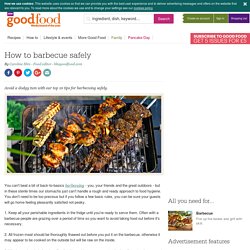
You don't need to be too precious but if you follow a few basic rules, you can be sure your guests will go home feeling pleasantly satisfied not peaky. 1. Keep all your perishable ingredients in the fridge until you're ready to serve them. Often with a barbecue people are grazing over a period of time so you want to avoid taking food out before it's necessary. 2. How to handle raw chicken. Having spent three years at catering college the importance of food hygiene was drummed into me military style - but it really is something every cook should be aware of.
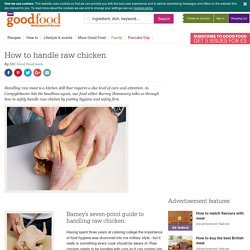
Raw chicken needs to be handled with care as it can contain lots of harmful bacteria that can make you very ill. Here are my seven pointers for ensuring optimum kitchen safety and hygiene. 1. Never wash chicken Droplets of water or spray-back from a fierce tap is one of the easiest ways of spreading the bacteria. 2. This means never use anything that has come into contact with raw chicken on cooked foods without washing them thoroughly first. 3. Never use a marinade that has been used on raw chicken to baste the chicken with as it cooks - this is just another form of cross-contamination. How to make vinaigrette. Vinaigrette. How to cook the perfect steak. Whether your preference is a butter-soft fillet steak, tasty sirloin or thrifty cut like bavette or skirt, care and attention should be paid when cooking your beef.

With only a few minutes leeway between rare and well-done, timing is key. We've put together some tips to help you from start to finish. Select your best frying pan We recommend frying your steak, although you can grill it if you prefer. A heavy-duty, thick-based frying pan, ideally with a non-stick coating, will achieve good results, as will a heavy griddle pan or skillet. If the pan isn’t big enough for all your steaks, don’t be tempted to squeeze them in anyway. Pick an oil. Lamb & apricot stew. How to prepare chillies.
How to crush garlic. BBC Good Food. How to make bread. Loaded: 0% Progress: 0% Mix the flour, salt and yeast in a large bowl.
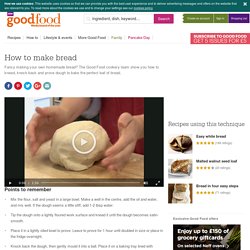
Make a well in the centre, add the oil and water, and mix well. If the dough seems a little stiff, add 1-2 tbsp water.Tip the dough onto a lightly floured work surface and knead it until the dough becomes satin-smooth.Place it in a lightly oiled bowl to prove. Leave to prove for 1 hour until doubled in size or place in the fridge overnight.Knock back the dough, then gently mould it into a ball. TipVideo recipeThis video uses our... BBC Good Food. Top 10 ways with leftover egg whites and yolks.
If you’re a keen baker, you'll be familiar with the process of fastidiously separating eggs.
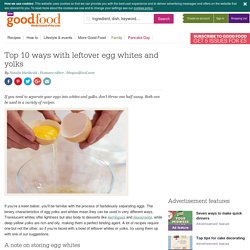
The binary characteristics of egg yolks and whites mean they can be used in very different ways. Translucent whites offer lightness but also body to desserts like meringues and macaroons, while deep yellow yolks are rich and oily, making them a perfect binding agent. A lot of recipes require one but not the other, so if you’re faced with a bowl of leftover whites or yolks, try using them up with one of our suggestions. A note on storing egg whites Our home economist Steffi says egg whites will keep in the fridge for up to two days, but they can also be frozen for up the three months. A note on storing egg yolks Egg yolks will also keep for two days in the fridge but dry out easily, especially when freezing, so we don’t recommend it. Always try to buy British Lion-branded eggs as they are protected against salmonella.
Top five ways of using up egg whites Meringue. How to make meringues video. How to cook rice. Rice is cooked in millions of households every day; it is one of the world's staple foods yet it's a dish that some people think they're incapable of cooking correctly.

Cooking rice is easy, provided you follow a few simple rules and choose the right method for your type of rice. Do this and we guarantee that you’ll never make a clumpy, sticky or glutinous mess again. How to make stock. How to make gravy. How to test/ joint a cooked chicken. BBC Good Food. Welcome to our roast calculator.
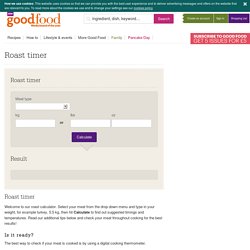
Select your meat from the drop down menu and type in your weight, for example turkey, 5.5 kg, then hit Calculate to find out suggested timings and temperatures. Read our additional tips below and check your meat throughout cooking for the best results! How to stuff a chicken for roasting. Crisp baked potatoes. Baked potato. How to make the perfect omelette video. BBC Good Food. How to melt chocolate. BBC Good Food. How to poach an egg. Perfect poached eggs – the type you get for breakfast in smart hotels and restaurants – can look impressive but if you master a few simple techniques, you can achieve the same results at home.
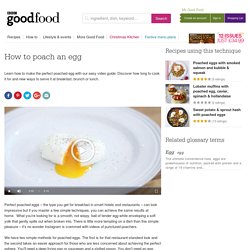
What you're looking for is a smooth, not wispy, ball of tender egg white enveloping a soft yolk that gently spills out when broken into. There is little more tempting on a dish than this simple pleasure – it's no wonder Instagram is crammed with videos of punctured poachers. We have two simple methods for poached eggs. The first is for that restaurant-standard look and the second takes an easier approach for those who are less concerned about achieving the perfect sphere. 25 skills every cook should know. We've put together a list of 25 key skills that every beginner cook should know in order to gain confidence in the kitchen... 1.

How to chop an onion The cornerstone of so many dishes, learning to chop an onion efficiently can speed up dinner preparations no end. Take a few moments out and learn how to slice like a pro with our how to chop an onion video below. We've also been discussing ways to keep the tears at bay; apparently, sucking on a teaspoon while chopping will keep your eyes dry. 2. Once you’ve mastered chopping onions, it’s time to broaden your knife skills and get to grips with scoring, shearing, fine slicing and more. How to buy pasta. Whether you do your pasta shopping in a supermarket or specialist Italian grocer, the broad selection now commonly available encompasses very different kinds of pasta. To help make sense of labels and characteristics, we've put together some basic guidelines.
Dried or fresh? Fresh pasta is best when it is homemade (or bought on the day it is made). The supermarket ‘fresh’ pastas can lack texture, and often break up when tossed through a sauce – and they’re usually double the price of the dried variety. 25 skills every cook should know. The anatomy of a knife. 1. The point The point at the very tip is used for piercing and scoring. It’s an important feature of a boning knife, where it’s used in a dagger fashion. 2. The tip The tip is the first third of the blade, used for fine slicing – for example, with garlic, onions and mushrooms. 3. The blade is the main body of the knife and its size, shape and strength varies according to purpose. 4. The belly or cutting edge is the part that works hardest when you’re chopping and slicing.
Knife skills. How to chop an onion.